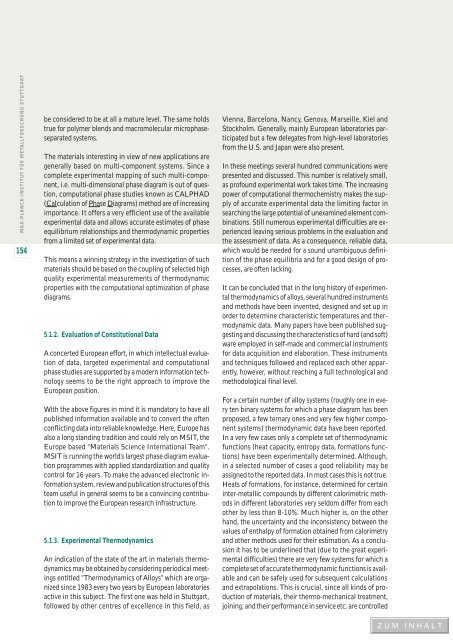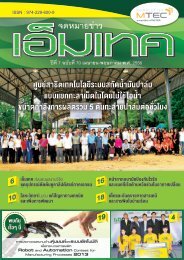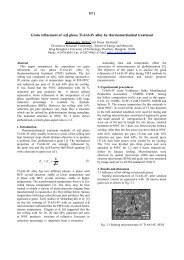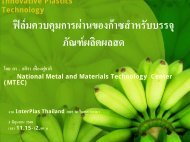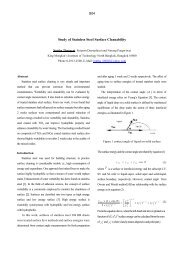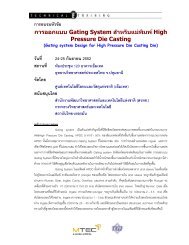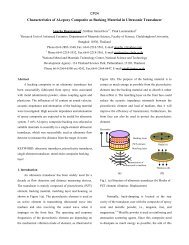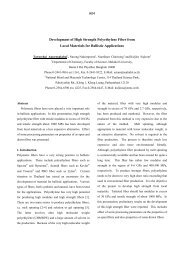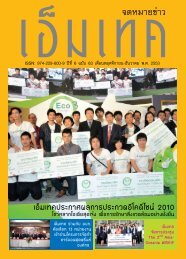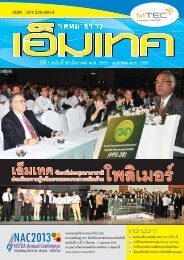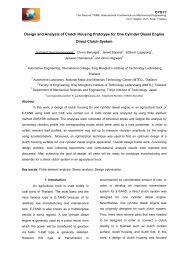EUROPEAN WHITE BOOK
EUROPEAN WHITE BOOK
EUROPEAN WHITE BOOK
You also want an ePaper? Increase the reach of your titles
YUMPU automatically turns print PDFs into web optimized ePapers that Google loves.
MAX-PLANCK-INSTITUT FÜR METALLFORSCHUNG STUTTGART154be considered to be at all a mature level. The same holdstrue for polymer blends and macromolecular microphaseseparatedsystems.The materials interesting in view of new applications aregenerally based on multi-component systems. Since acomplete experimental mapping of such multi-component,i.e. multi-dimensional phase diagram is out of question,computational phase studies known as CALPHAD(Calculation of Phase Diagrams) method are of increasingimportance. It offers a very efficient use of the availableexperimental data and allows accurate estimates of phaseequilibrium relationships and thermodynamic propertiesfrom a limited set of experimental data.This means a winning strategy in the investigation of suchmaterials should be based on the coupling of selected highquality experimental measurements of thermodynamicproperties with the computational optimization of phasediagrams.5.1.2. Evaluation of Constitutional DataA concerted European effort, in which intellectual evaluationof data, targeted experimental and computationalphase studies are supported by a modern information technologyseems to be the right approach to improve theEuropean position.With the above figures in mind it is mandatory to have allpublished information available and to convert the oftenconflicting data into reliable knowledge. Here, Europe hasalso a long standing tradition and could rely on MSIT, theEurope based “Materials Science International Team”.MSIT is running the world’s largest phase diagram evaluationprogrammes with applied standardization and qualitycontrol for 16 years. To make the advanced electronic informationsystem, review and publication structures of thisteam useful in general seems to be a convincing contributionto improve the European research infrastructure.5.1.3. Experimental ThermodynamicsAn indication of the state of the art in materials thermodynamicsmay be obtained by considering periodical meetingsentitled “Thermodynamics of Alloys” which are organizedsince 1983 every two years by European laboratoriesactive in this subject. The first one was held in Stuttgart,followed by other centres of excellence in this field, asVienna, Barcelona, Nancy, Genova, Marseille, Kiel andStockholm. Generally, mainly European laboratories participatedbut a few delegates from high-level laboratoriesfrom the U.S. and Japan were also present.In these meetings several hundred communications werepresented and discussed. This number is relatively small,as profound experimental work takes time. The increasingpower of computational thermochemistry makes the supplyof accurate experimental data the limiting factor insearching the large potential of unexamined element combinations.Still numerous experimental difficulties are experiencedleaving serious problems in the evaluation andthe assessment of data. As a consequence, reliable data,which would be needed for a sound unambiguous definitionof the phase equilibria and for a good design of processes,are often lacking.It can be concluded that in the long history of experimentalthermodynamics of alloys, several hundred instrumentsand methods have been invented, designed and set up inorder to determine characteristic temperatures and thermodynamicdata. Many papers have been published suggestingand discussing the characteristics of hard (and soft)ware employed in self-made and commercial instrumentsfor data acquisition and elaboration. These instrumentsand techniques followed and replaced each other apparently,however, without reaching a full technological andmethodological final level.For a certain number of alloy systems (roughly one in everyten binary systems for which a phase diagram has beenproposed, a few ternary ones and very few higher componentsystems) thermodynamic data have been reported.In a very few cases only a complete set of thermodynamicfunctions (heat capacity, entropy data, formations functions)have been experimentally determined. Although,in a selected number of cases a good reliability may beassigned to the reported data. In most cases this is not true.Heats of formations, for instance, determined for certaininter-metallic compounds by different calorimetric methodsin different laboratories very seldom differ from eachother by less than 8-10%. Much higher is, on the otherhand, the uncertainty and the inconsistency between thevalues of enthalpy of formation obtained from calorimetryand other methods used for their estimation. As a conclusionit has to be underlined that (due to the great experimentaldifficulties) there are very few systems for which acomplete set of accurate thermodynamic functions is availableand can be safely used for subsequent calculationsand extrapolations. This is crucial, since all kinds of productionof materials, their thermo-mechanical treatment,joining, and their performance in service etc. are controlled


